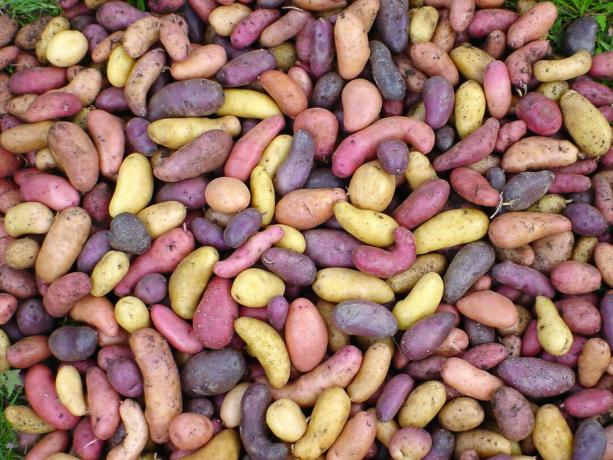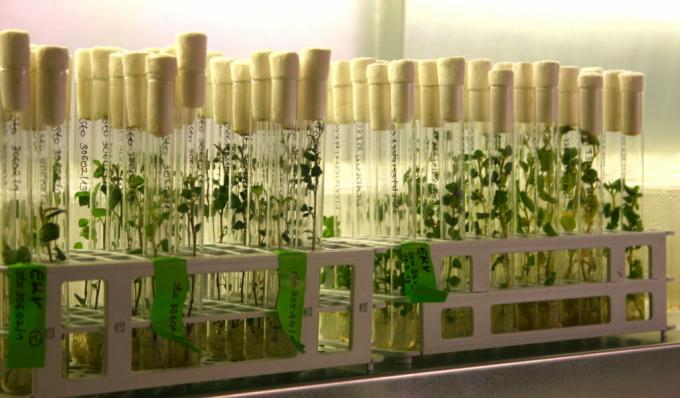Not all potatoes are the same: the popular tuber offers a wide variety and hardly any other place has as many as the Ellenbergs' farm.

Karsten Ellenberg is a passionate potato grower. On his farm in Barum, he grows a wide variety of varieties. There he has dedicated himself to the preservation of old varieties and also breeds his own, which, in contrast to the supermarket potatoes, have a variety of different properties. In an interview, he talks about this variety of potatoes, the most popular varieties in Germany, and gives tips for growing them in your own garden.
Potatoes seem to be the great passion of you and your family. How did that happen?
I grew up with potatoes. My father grew potatoes, and my grandparents before him. Potatoes have always been great, both for farming and for our family. Overall, they are easy to grow and high yielding, easy to store, and there was always some money to be made. And they taste good anyway.
When did it come about that you turned your attention to special potato varieties?
In 1990 we switched to organic farming and in the late 90s I started making old ones potato varieties to collect. We saw that people used to simply cross the varieties. So we started breeding a bit ourselves. That was totally fascinating. Something like blue potatoes was completely unknown to me as a farmer. And just as the different varieties look different, they are of course also different in taste. We then developed the variety of potatoes.
You now have an enormous variety of different types of potatoes. How many are there exactly?
We have around 150 varieties, of which around 35-40 varieties are cultivated for distribution each year. The rest are taken for breeding and observation only and placed in the archive for future reference. So we are practically independent.
Of course, we also exchange information with gene banks, for example with the potato gene bank in Groß Lüsewitz near Rostock. I'm also in contact with Edinburgh, with the potato gene bank there. This is one of the largest in Europe. I am also in contact with the world's largest potato gene bank in Lima, Peru. They have very interesting varieties. So the variety doesn't stop there.
With such a large variety, what are the differences between the varieties?
The European varieties or those that are so common in the trade differ only slightly.
The older varieties or the wild potatoes are a lot more diverse. On the one hand, these can be distinguished by the color of the shell. It can vary from light yellow to red-yellow spotted to black-purple. Of course, the flesh color of the potato and the shape of the tubers can be just as different. And they taste just as different as they look. Everything is included between tart, earthy-tart, strong, sweet, buttery, nutty and floury. Also, each person has their own preferences in the taste of the potato. There are varieties that one likes very much and another, for example, doesn't like at all.

Why is it so important to you to preserve potato diversity?
What is important is that there is a variety that is accessible to the consumer and that there are different shapes, colors and flavor nuances. If you have a universal variety worldwide, the retailer can buy where the variety is cheapest. But if you have varieties that are more versatile, you are not that interchangeable as a farmer. In addition, potatoes are often infested with harmful organisms. Viruses, bacteria, and fungi can all cause strains to fail. To counteract this, resistance is used in modern breeding. However, pollutants and harmful organisms can always re-emerge. On the other hand, if you have a large variety of varieties, there is a higher probability that resistance will arise by chance.
Speaking of breeding, how does it even work?
In addition to vegetative reproduction, there is sexual reproduction. When the potato blooms, I can bring the pollen of another variety over to this plant and a potato berry develops. The berry and its small seeds, which I dry, are the key to cultivation. Every seed can become a new variety. Although they are related to each other, they are genetically different. The task of breeding is to select, depending on what my wishes are. With us in organic cultivation, we want a variety that can hold its own by growing faster and more vigorously than the wild herbs. Even with less fertilizer and only with organic fertilizer, it should grow well and have as few resistances as possible. Of course, it also has to taste good, because that's what matters in the end.
Any hobby gardener can do it too: take a berry and let it ripen until it's a bit soft. The seeds are then washed out of the berries and can be planted next spring.

What kind of varieties can we expect from you in the future?
I can never say for sure, because nature has its own rules. At the moment we are breeding on a deep yellow variety. It's still maturing a bit, but I'm curious how it tastes. Our flavors are also relatively new. These are Heidemarie, Rote Emmalie and Blaue Anneliese. I like to be surprised by nature. Many varieties are so different in taste. In addition to the standard type of potato, the Solanum tuberosum, there are also other types of potatoes like that Solanumphureja. The potato varieties of this type, such. B. the ˈMayan Twilightˈ or the ˈMayan Goldˈ taste slightly sweet. In terms of taste, you can still develop a lot with the potato varieties, which can then later be available on the market. I'm still curious about that myself.
But now tell me: what are the most popular varieties among Germans?
As has been the case for many years, this is the ˈLindaˈ. This is a waxy, yellow-fleshed variety. Then there is the red-skinned ˈLauraˈ, which is very popular. There is the ˈAnnabelleˈ, which is an early, newer variety that also has its aroma early on. The ˈAgriaˈ is deep yellow and is often used for fries. In the floury range, for example, we have the ˈGundaˈ, which is also a newer variety. There is also the ˈAdrettaˈ, which comes from Germany and is a slightly older variety with a strong aroma.
Do you have a personal favourite?
The ˈBlue Annelieseˈ. It is deep blue, waxy and beautifully greasy, so that it also has a nice aroma.

Assuming I want something really fancy and exotic, which one would you recommend?
Again the ˈBlaue Annelieseˈ or the ˈHeiderotˈ, they both have nice colored flesh.
A newer variety is, for example, ˈNemoˈ. With its red and yellow shell, it reminds a little of an anemone fish. It is mealy and rather fruity and comes from a Dutch breeder.

I now suspect that not every variety thrives equally well in the home garden. Which varieties would you recommend our readers to grow in their own gardens?
Definitely the ˈLindaˈ, because it grows everywhere in Germany and also tolerates a bit of drought. The ˈHeiderotˈ and the ˈBlaue Annelieseˈ are very robust in cultivation. Both of them ripen a little later, so they are not necessarily suitable as early potatoes, but they are wonderful afterwards in the warehouse. It can also be grown anywhere in Germany.
Now I'm taking the chance to talk to a potato professional again: what should a hobby gardener consider when growing potatoes?
It's important to choose hardy varieties that you can plant again the year after and don't have to buy new seedlings right away. In cultivation, it is convenient to have an early and a late variety. So you have something to eat early and can then better store the late ones. One early variety would be, for example, the ˈAnnabelleˈ. To the storage you can sometimes use the fridge if you don't have a cold basement. It is only important that the potatoes are stored in the dark, otherwise they will turn green from sunlight or lamplight. You can also try your hand at more specialized varieties, like the fingerling varieties. There we have the ˈLa Ratteˈ or the ˈAngeliter Pine Coneˈ, the ˈRosa Pine Coneˈ and the ˈBamberger Krumbeereˈ. These are varieties that are a bit more difficult to harvest due to their shape and size, but you can do it by hand. They are very interesting in terms of taste.

To finish, I have one last question: Your whole job revolves around potatoes. How does your private garden look like? Do you also grow potatoes there?
In our garden we have more fruit trees and other fruits, raspberries and a few strawberries that I don't have in the field. But for me, the fields are actually my garden.
If you want to learn more about the variety of potato varieties, the best place to look is here at the farm Ellenberg family past.
